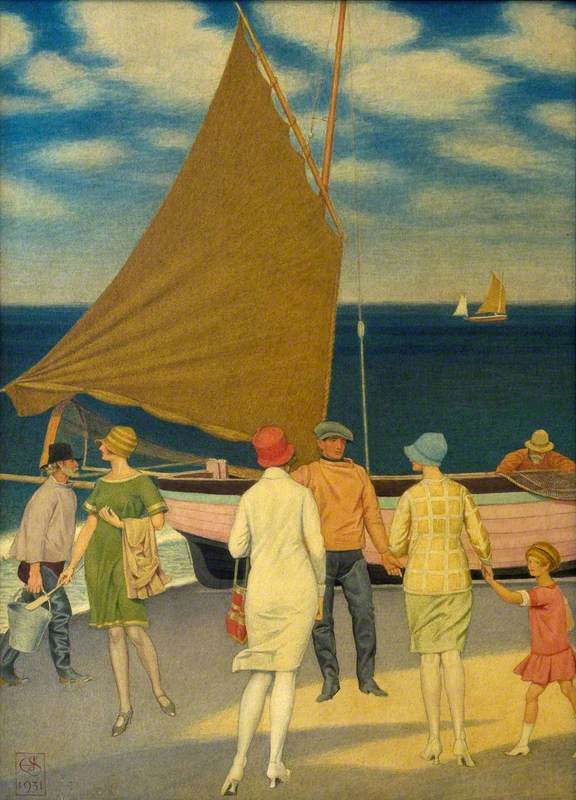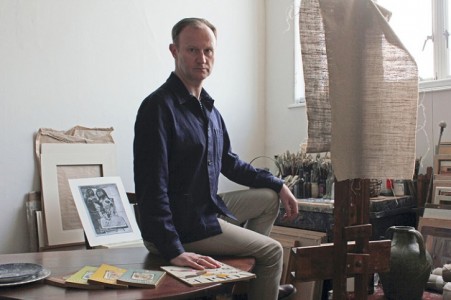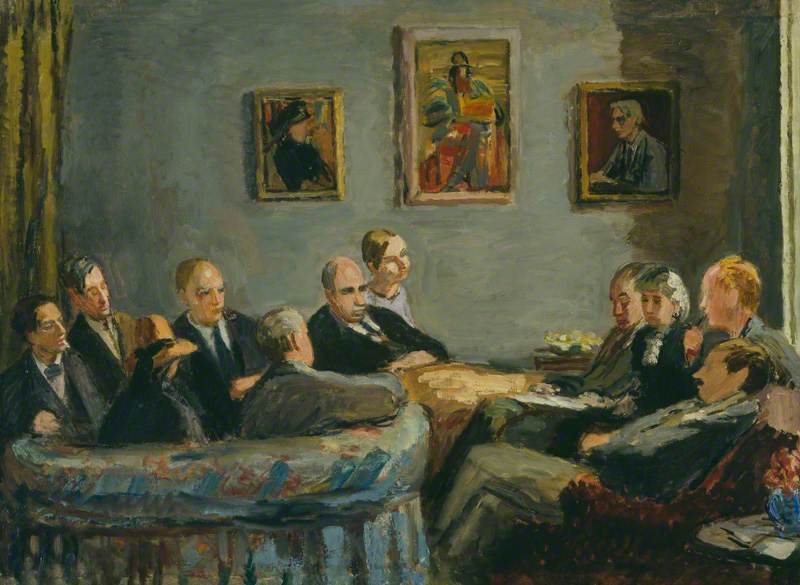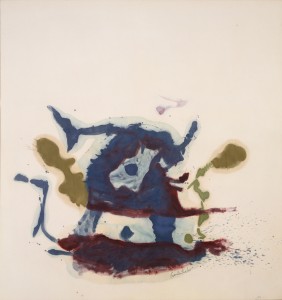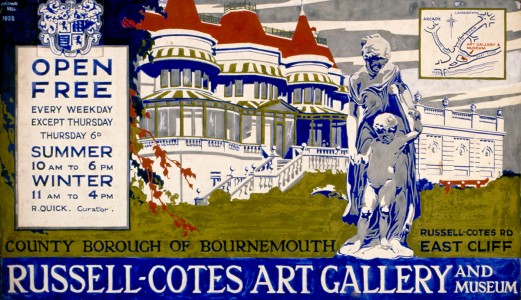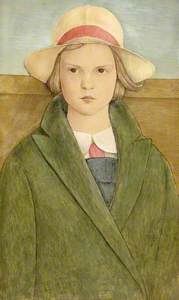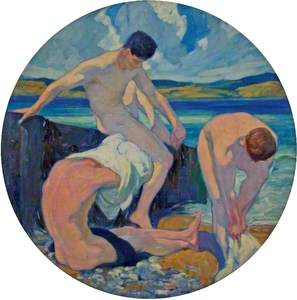The heart of the collection at the Russell-Cotes Art Gallery & Museum in Bournemouth is the Victorian art and sculpture collected by the founders Annie and Merton Russell-Cotes in the nineteenth century. After their deaths in 1920 and 1921, the first curators faced an interesting dilemma as the world in general, and art in particular, went through a period of unprecedented change. Should they continue collecting contemporary art? How would twentieth-century art sit in this high Victorian villa?
Poster Design for the Russell-Cotes Art Gallery & Museum
1922
Arthur Bell (1897–1995) 
The first curator, Richard Quick, was personally appointed by Merton and Annie but did not actively buy work, rather adding to the collection through donations and bequests. However, his successor, Norman Silvester (curator from 1932 to 1958) tirelessly encouraged contemporary art through an extensive exhibition programme through which he was able to buy new work. He focused particularly on paintings by local artists when the local art scene, led by the Bournemouth Arts Club, was particularly vibrant and active, as well as national names through the Contemporary Arts Society and the War Artists Advisory Committee.
These curators chose to collect contemporary Modernist work by British artists which responded to familiar themes, present in Annie and Merton’s collection, such as portraiture, landscape and still lives. The works therefore complemented and provided a twentieth-century response to the Victorian art. The curators collected in an eclectic manner, as had Merton, rather than systematically attempting to be inclusive of all the current art styles and fashions.
This exhibition asks what visitors think of their choices today.
Harold Williamson was painting master at Bournemouth School of Art from 1926 to 1947 and had previously taught at Manchester School of Art. His students admired his skill at life drawing and knowledge of anatomy, as demonstrated in this painting with the modelling of the swimmer’s back in this virtuoso angle with the vertiginous view to the rock pool below.
Williamson was known to have used his daughter, and her friends, as models for his work. The model for Spray is unknown.
This painting was exhibited at the Royal Academy and was bought by Norman Silvester for £50 because of the artist’s local connection.
John Minton was a celebrated figure in Neo-Romanticism and London’s Bohemia of the 1940s. He was a member of the London Group, formed by a band of radical artists to offer additional exhibiting opportunities to artists besides the Royal Academy of Arts.
Minton’s main artistic theme, partly homoerotic, was the young male figure in an emotionally charged setting. In this painting, Minton alters the traditional dynamic between the dominant artist and their passive model. The model was his friend, the actor Norman Bowler, best known for his role as Frank Tate in the TV series Emmerdale.
Minton was himself gay, at a time when homosexuality was illegal, and was often attracted to unavailable men. Outwardly a charming and charismatic figure, he struggled with self-doubt and self-destruction and aged 39 took his own life with a drug overdose.
John Downton was a Cambridge-educated, Slade-trained artist and philosopher whose work was a rejection of the modern world and a return to the art of the early Renaissance. This painting shows a very believable likeness of Nora Russell, the ten-year old daughter of a friend of Downton. Although Nora is depicted in her school uniform of hat, tie and pinafore, she is painted in the manner of Italian Renaissance masters and using a tempera technique.
Downton was a Christian pacifist, who was a conscientious objector during the Second World War. He travelled extensively in Europe and adopted the ethos of artist/craftsman in the tradition of William Morris and the Arts and Crafts Movement.
Near Worbarrow Bay, Dorset
1930
Philip Leslie Moffat Ward (1888–1978) 
With its bright colour palette and stylised landscape, this painting is strongly influenced by Roger Fry, the Bloomsbury Group and the Post-Impressionists. It shows an idyllic view of the Purbeck coast, with walkers enjoying the rolling hills and the views to sea.
After the devastation of the First World War, many British artists returned to traditional methods and subjects such as landscapes, albeit displaying an enormous diversity of artistic approaches. However, even in 1930, it was evident that such tranquil spots were under threat from coastal ribbon developments and the gathering storm clouds over Europe.
Cliff End, Studland, Dorset
1909–1910
Harry van der Weyden (1868–1952) 
Harry van der Weyden was born in Boston, Massachusetts but trained at the Slade School of Art, London and the Académie Julian in Paris. He was one of a number of artists in the early twentieth century drawn to the British coast and landscape. His bright colour palette and reductive, stylised technique were influenced by French Impressionism and the Bloomsbury group.
This work depicts an extensive view of Standfast Point, Swanage and enables Van der Weyden to capture the shimmering translucent qualities of the sea.
Joseph Southall visited Southwold in Suffolk each year and painted a number of works featuring fashionable ladies of the period alongside fishermen with their boats, set against a background of the flat sandy beach and sea. Here he creates an interesting composition of elegant ladies, some ignoring and some conversing with the fishermen whilst the young girl gazes back at us, the spectator.
Southall paid considerable attention to historic and contemporary fashions and accessories, taking a keen interest in the fashions on the street in London, and making studies in the museums and in his studio of models in costume.
This carefully constructed and dramatic painting of three bathing young men has echoes of the work of Michelangelo in its treatment of the figures, and the sculptor Rodin in its poses.
Alfred Palmer trained at the Royal Academy schools but then went on to study at the Académie Julian in Paris in 1903, where he was exposed to the continental influences of Impressionism and Modernism.
Palmer was a prolific artist who travelled widely, working in a variety of media and subject matter. He lived and worked in Swanage during the Second World War, where he painted a number of scenes of Purbeck quarrymen at work.
'The Open Window', These Are My Jewels
1937
William Bruce Ellis Ranken (1881–1941) 
William Ranken was born into a wealthy family in Edinburgh and educated at Eton and at the Slade, under Henry Tonks. Socially connected with the rich and famous, his first painting commission was obtained in America through his connections with the artist John Singer Sargent. Based in America during the 1920s, he was in constant demand to paint the cream of New York society including the Whitneys and Vanderbilts.
Financially ruined by the Great Depression, in 1935 he was forced to return to London where he painted royalty and aristocracy, as well as their houses. This painting, of a wealthy woman and her children, would have been a private commission during this period.
Sarah Newman, Programmes Officer
'Meeting Modernism' was open until 23rd April 2017 at the Russell-Cotes Art Gallery & Museum, Bournemouth



